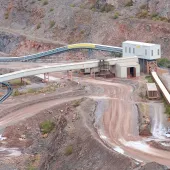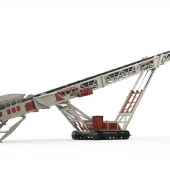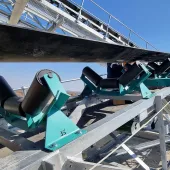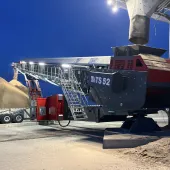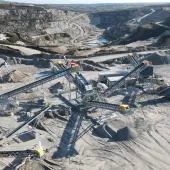Canning conveyors for RMC Marine
Having recently supplied a new ship discharge conveyor for RMC Marine, Canning Conveyor have just completed a further element of the project by delivering a new stockpile conveyor built specifically for the dredger MV Sand Serin.
Forming an essential part of the ship’s unloading system, Canning have designed, manufactured and supplied a new 1,500 mm wide x 19m drum centres, troughed-belt, stockpile conveyor of lattice-frame construction. This accepts up to 1,200 tonnes/h of sea-dredged sand and gravel from the Sand Serin’s new discharge conveyor and elevates it at an angle of 20° to a discharge height of 10m to form conical ground stockpile of around 3,400 tonnes capacity.
The conveyor was supplied complete with belt scraper and features a short stairway for access; a 750mm wide, full-length walkway along one side; a maintenance platform around the head end; a 45kW drive unit; and an emergency stop pull-wire system in all accessible areas.
Following on from the Sand Serin project, Canning have also recently been awarded a contract to supply and fit a ship discharge conveyor on sister vessel MV Welsh Piper. This project calls for the design and manufacture of a new 1,200mm wide x 16.5m drum centres, troughed-belt, radial boom conveyor, which will discharge material at up to 1,200 tonnes/h, based on a bulk density of 1.6 tonnes/m3 at a belt speed of 3.1m/s.
The conveyor boom will be fully fabricated, braced and stiffened, and designed to accept material from the existing loading system via a loading hopper fabricated from 6mm thick mild steel plate. This will be stiffened with RSA sections and lined with 10mm thick low-friction white Perplas on all sloping surfaces.
The boom will pivot at the tail end by means of two heavy-duty machined pivot pins that will be mounted on two new pivot trunnions, which will be raised as high as possible above deck. This boom will be raised and lowered by means of the existing luffing winch, which will be removed from its existing position and fitted to the new boom.
The conveyor slew will be controlled by a new, internal-type slewing ring that will be fitted to the new raised deck mounting. Slewing will be driven by two hydraulic motors powered by a power pack located in the engine room; this will be operated by levers on the bridge.



